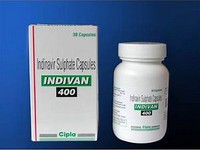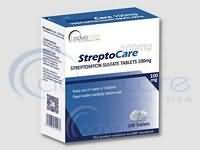indinavir

indinavir
CLINICAL USE
Protease inhibitor:Treatment of HIV infection, in combination with a nucleoside reverse transcriptase inhibitor
DOSE IN NORMAL RENAL FUNCTION
800 mg every 8 hours
PHARMACOKINETICS
Molecular weight :711.9 (as sulphate) %Protein binding :60 %Excreted unchanged in urine : 10.4 Volume of distribution (L/kg) :14half-life – normal/ESRD (hrs) :1.8/Unchanged DOSE IN RENAL IMPAIRMENT
GFR (mL/MIN)
20 to 50 : Dose as in normal renal function Monitor closely 10 to 20 : Dose as in normal renal function Monitor closely <10 : Dose as in normal renal function Monitor closely DOSE IN PATIENTS UNDERGOING RENAL REPLACEMENT THERAPIES
CAPD :Unlikely to be dialysed. Dose as in GFR <10 mL/min HD :Not dialysed. Dose as in GFR <10 mL/minHDF/high flux :Not dialysed. Dose as in GFR <10 mL/minCAV/VVHD :Unlikely to be dialysed. Dose as in GFR 10 to 20 mL/min IMPORTANT DRUG INTERACTIONS
Potentially hazardous interactions with other drugsAnti-arrhythmics: possibly increased amiodarone concentration – avoid concomitant useAntibacterials: rifampicin increases metabolism – avoid concomitant use; increased rifabutin concentration and rifabutin reduces indinavir concentration – reduce dose of rifabutin by 50% and increase dose of indinavir; avoid with telithromycin in severe renal and hepatic failureAntidepressants: plasma concentration reduced by St John’s wort – avoid concomitant useAnti-epileptics: concentration possibly reduced by carbamazepine, phenytoin, primidone and barbiturates Antifungals: ketoconazole inhibits metabolism – reduce dose of indinavir to 600 mg every 8 hours; concentration increased by itraconazole – consider reducing indinavirAntimalarials: avoid concomitant use with artemether/lumefantrineAntipsychotics: possibly increased risk of ventricular arrhythmias with pimozide and sertindole – avoid concomitant use; possibly inhibits aripiprazole metabolism – reduce aripiprazole doseAntivirals: avoid with atazanavir; concentration reduced by efavirenz and nevirapine; with nelfinavir and darunavir, concentration of both drugs increased; concentration increased by ritonavir; saquinavir concentration increasedAnxiolytics and hypnotics: increased risk of prolonged sedation with alprazolam and midazolam – avoid concomitant useCilostazol: concentration of cilostazol possibly increased – avoid concomitant use Ergot alkaloids: risk of ergotism – avoid concomitant useLipid-regulating drugs: increased risk of myopathy with simvastatin – avoid concomitant use; and possibly with atorvastatin5HT 1 agonists: concentration of eletriptan increased – avoid concomitant useSildenafil: concentration of sildenafil increased – reduce initial sildenafil dose Vardenafil: concentration of vardenafil increased – avoid concomitant use ADMINISTRATION
Reconstition
– Route
Oral Rate of Administration
–Comments
Drink 1.5 litres of water in 24 hours .380 indinAVirGive 1 hour before, or 2 hours after food, or with a low fat meal with water OTHER INFORMATION
If giving with didanosine, leave 1 hour between each drugMild renal insufficiency is usually due to crystalluria, but a case of interstitial nephritis has been reportedIf nephrolithiasis with flank pain occurs (with or without haematuria), temporarily stop therapy (e.g. for 1–3 days)
See how to identify renal failure stages according to GFR calculation
See how to diagnose irreversible renal disease
Home









